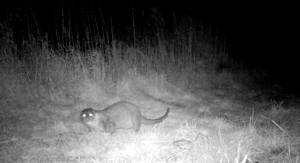Wild otters caught on camera for very first time
Wild otters living on the River Wear have been captured on camera by WWT Washington Wetland Centre for the very first time.
 Filmed using a motion sensor camera on loan from Durham Wildlife Trust, the night-time footage shows an inquisitive otter exploring its territory and grooming itself, before a noisy spat breaks out between two otters; possibly an adult and a juvenile.
Filmed using a motion sensor camera on loan from Durham Wildlife Trust, the night-time footage shows an inquisitive otter exploring its territory and grooming itself, before a noisy spat breaks out between two otters; possibly an adult and a juvenile.
The camera was set up over a period of a few weeks in late autumn, as part of a project to monitor otter populations in the region, and also recorded two passing foxes, a jay seemingly searching for its buried acorns and a male pheasant followed by a parade of females.
WWT Washington’s reserve manager John Gowland said: “We knew we had wild otter living on the River Wear beneath our site. There have been various sightings over the last three years and more recently, tracks have been regularly appearing down at our new saline lagoon habitat.
“When we installed the camera, we hoped that we might capture some fleeting glimpses at best, so to have such great footage of not one, but two otters is just fantastic.”
The camera was installed at the southern end of WWT Washington’s wildlife reserve, near the River Wear corridor and within the centre’s new saline lagoon, which is due to open next year.
Careful monitoring of this habitat as it establishes has revealed it is already attracting an array of new wildlife, including roe deer, oystercatchers, common terns and otters; which are using the site as a thoroughfare between a mature river reedbed and the new lagoon – dubbed the ‘otter highway’ by the wardens.
“Who knows, once the new saline lagoon is open and the otter feels safe to do so, he may well continue to use this route as visitors watch from the view point,” added John.
The camera was loaned to WWT by Durham Wildlife trust as part of an ongoing project to boost wild otter populations in the region.
Vivien Kent, PhD, Otter Project Officer with Durham Wildlife Trust said: “The Durham Biodiversity Action Plan Otter Project works to improve and restore habitat for otters across the Durham Biodiversity Partnership area in partnership with several councils, the Environment Agency and Northumbrian Water.
The work includes the installation of artificial holts, the creation of reedbeds and the improvement of river channels to facilitate the recolonisation by otters of rivers across the area.
“The project has been running for nearly three years and has installed over 30 artificial holts to date.”
Did you know?..
The European otter (Lutra lutra), is a European and Asian member of the Lutrinae or otter sub-family and is typical of freshwater otters.
It declined across its range in the second half of the 20th century, primarily due to pollution from pesticides and other threats including habitat loss and hunting.
However, the number of sites with an otter presence increased by 55% between 1994 and 2002 and in August 2011, the Environment Agency announced that otters had returned to every county in England, since vanishing from every county except the West Country and parts of Northern England.
Recovery is due partly to a ban on the most harmful pesticides, which has been in place across Europe since 1979; partly to improvements in water quality leading to increases in prey populations and partly to direct legal protection under the European Union Habitats Directive and national legislation in several European countries.
The European otter is listed as near-threatened on the IUCN Red List.
Otter footage can be viewed by clicking Here.
Watch the wildlife video in full here.



